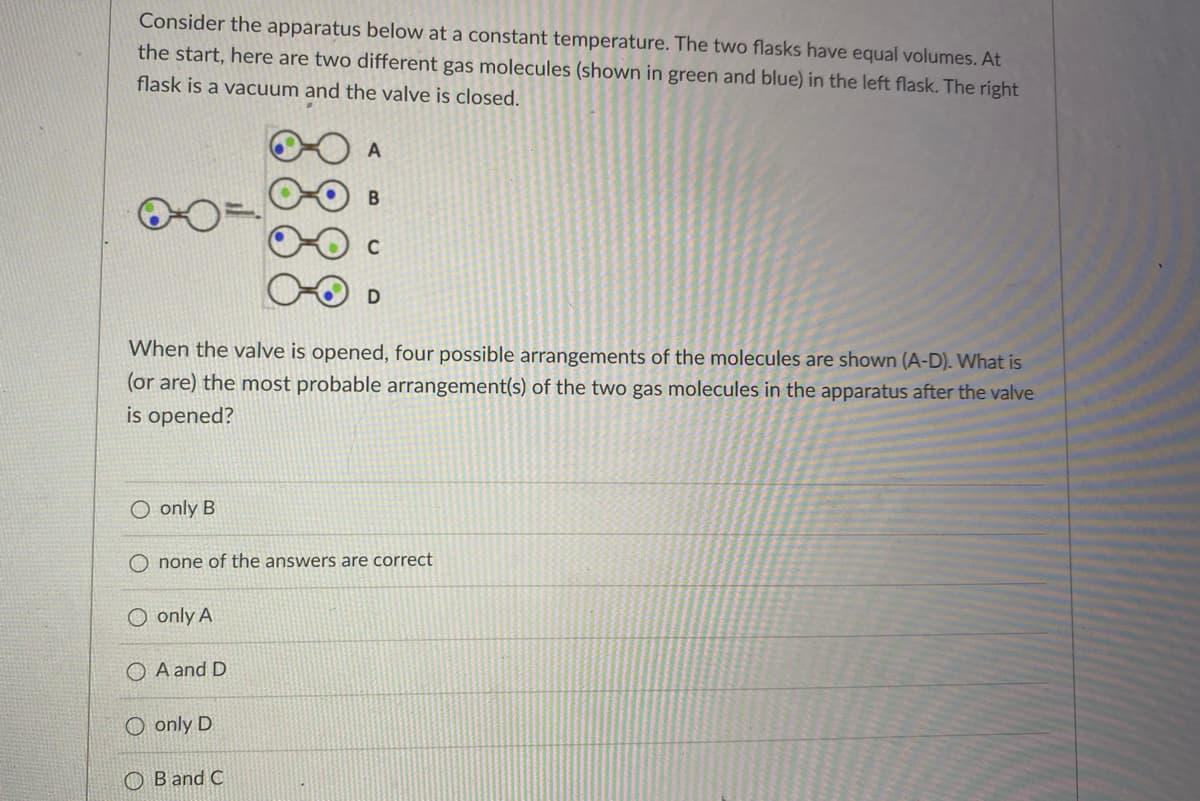Consider the apparatus below at a constant temperature. The two flasks have equal volumes. At the start, here are two different gas molecules (shown in green and blue) in the left flask. The right flask is a vacuum and the valve is closed. C D When the valve is opened, four possible arrangements of the molecules are shown (A-D). What is (or are) the most probable arrangement(s) of the two gas molecules in the apparatus after the valve is opened? only B O none of the answers are correct
Consider the apparatus below at a constant temperature. The two flasks have equal volumes. At the start, here are two different gas molecules (shown in green and blue) in the left flask. The right flask is a vacuum and the valve is closed. C D When the valve is opened, four possible arrangements of the molecules are shown (A-D). What is (or are) the most probable arrangement(s) of the two gas molecules in the apparatus after the valve is opened? only B O none of the answers are correct
Chemistry: Principles and Reactions
8th Edition
ISBN:9781305079373
Author:William L. Masterton, Cecile N. Hurley
Publisher:William L. Masterton, Cecile N. Hurley
Chapter5: Gases
Section: Chapter Questions
Problem 79QAP
Related questions
Question

Transcribed Image Text:Consider the apparatus below at a constant temperature. The two flasks have equal volumes. At
the start, here are two different gas molecules (shown in green and blue) in the left flask. The right
flask is a vacuum and the valve is closed.
C
D
When the valve is opened, four possible arrangements of the molecules are shown (A-D). What is
(or are) the most probable arrangement(s) of the two gas molecules in the apparatus after the valve
is opened?
O only B
O none of the answers are correct
O only A
O A and D
O only D
O B and C
Expert Solution
This question has been solved!
Explore an expertly crafted, step-by-step solution for a thorough understanding of key concepts.
This is a popular solution!
Trending now
This is a popular solution!
Step by step
Solved in 2 steps

Knowledge Booster
Learn more about
Need a deep-dive on the concept behind this application? Look no further. Learn more about this topic, chemistry and related others by exploring similar questions and additional content below.Recommended textbooks for you

Chemistry: Principles and Reactions
Chemistry
ISBN:
9781305079373
Author:
William L. Masterton, Cecile N. Hurley
Publisher:
Cengage Learning

Chemistry: The Molecular Science
Chemistry
ISBN:
9781285199047
Author:
John W. Moore, Conrad L. Stanitski
Publisher:
Cengage Learning

Chemistry: Principles and Practice
Chemistry
ISBN:
9780534420123
Author:
Daniel L. Reger, Scott R. Goode, David W. Ball, Edward Mercer
Publisher:
Cengage Learning

Chemistry: Principles and Reactions
Chemistry
ISBN:
9781305079373
Author:
William L. Masterton, Cecile N. Hurley
Publisher:
Cengage Learning

Chemistry: The Molecular Science
Chemistry
ISBN:
9781285199047
Author:
John W. Moore, Conrad L. Stanitski
Publisher:
Cengage Learning

Chemistry: Principles and Practice
Chemistry
ISBN:
9780534420123
Author:
Daniel L. Reger, Scott R. Goode, David W. Ball, Edward Mercer
Publisher:
Cengage Learning


Chemistry
Chemistry
ISBN:
9781305957404
Author:
Steven S. Zumdahl, Susan A. Zumdahl, Donald J. DeCoste
Publisher:
Cengage Learning

Chemistry: An Atoms First Approach
Chemistry
ISBN:
9781305079243
Author:
Steven S. Zumdahl, Susan A. Zumdahl
Publisher:
Cengage Learning